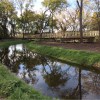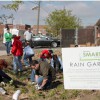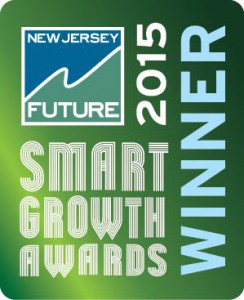Grassroots Collaboration on Green Infrastructure
Project Name: Camden SMART
Partnership of community organizations working to construct green and grey infrastructure
Partners: Collaboration of six organizations, led by Cooper’s Ferry Partnership; City of Camden; Camden County Municipal Utilities Authority
Smart-Growth Challenge: How can communities begin to address local water infrastructure inadequacies?
Like many cities, Camden manages its stormwater with an aging and overtaxed combined sewer system. The system can no longer handle even the small additional quantity of stormwater that comes from a regular rain event, resulting in backups into streets, parks and sometimes even basements. This presents a significant public-health problem, and has a negative effect on the city’s economic viability.
Large-scale upgrades to the sewer system, known collectively as “grey infrastructure,” are expensive and take time to implement. But in 2011 a coalition of community, municipal and other leaders formed a coalition to tackle the challenge by implementing smaller-scale “green infrastructure” initiatives designed to keep some of the stormwater out of the sewer system. The result is Camden SMART (for Stormwater Management and Resource Training), a community-driven movement to protect human health, improve conditions for economic development, improve water quality and enhance quality of life for Camden residents. Coalition members include Cooper’s Ferry Partnership, the City of Camden, the Camden County Municipal Utilities Authority, the Rutgers Cooperative Extension Water Resources Program, the New Jersey Tree Foundation and the New Jersey Department of Environmental Protection.

Camden SMART Delaware Avenue flooding

Camden SMART Baldwin's run daylighting and trail project

Camden SMART volunteers planting trees

Camden SMART volunteers planting a rain garden
To date, Camden SMART’s projects have captured, diverted, treated and infiltrated more than 4.3 million gallons of stormwater each year that would otherwise have contributed to combined-sewer overflows. The coalition has distributed more than 120 rain barrels to city residents that they can use to capture stormwater from their roofs, and has 39 green-infrastructure installations throughout the city. In addition, the coalition has engaged almost 3,900 city residents, has hosted 33 educational events and has partnered with 35 other organizations to develop green-infrastructure projects and programs. Many of Camden SMART’s projects have been integrated into, and often enhance, existing development or redevelopment plans, and one of the organization’s key objectives is education and engagement of city residents through volunteer events and participation at public meetings.
Financing for many of the projects is made possible in part by a $4.5 million loan from the DEP’s Environmental Infrastructure Trust to the Camden County Municipal Utilities Authority. But Camden SMART is a volunteer organization with no dedicated funding and no paid staff, relying instead on the “collective impact” model of community action. And it has laid the groundwork for a broader collaboration called the Camden Collaborative Initiative, or CCI, which is focusing on key areas such as air and ground pollution, environmental justice and education, and recycling, in a larger effort to help enhance the quality of life in the city.
Supporting partners: New Jersey Department of Environmental Protection; New Jersey Tree Foundation; Rutgers Cooperative Extension Service Water Resources Program












